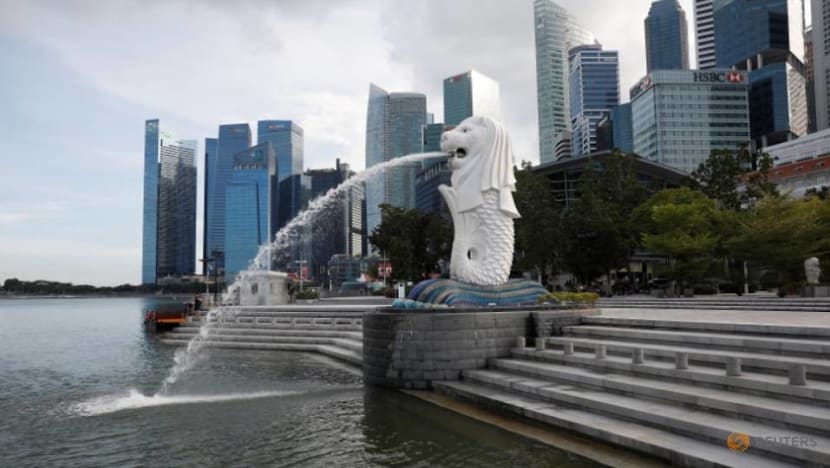Campaign to encourage domestic tourism will cushion COVID-19 blow, but not make up for drop in international travel, say observers

A water feature is seen in an empty Merlion Park, as tourism braces for a steep decline following the outbreak of coronavirus disease (COVID-19) along Marina Bay in Singapore, March 26, 2020. REUTERS/Edgar Su
SINGAPORE: A new campaign to encourage domestic tourism will help cushion the impact of COVID-19 on Singapore’s tourism sector, but is unlikely to make up for the steep drop in overseas tourists resulting from the pandemic, observers said.
Instead, what could help stimulate the tourism industry in the short term is the establishment of “travel bubbles”, where visitors can be assured of safe travel between specific countries, they said.
This comes after Wednesday’s announcement that the Singapore Tourism Board, Enterprise Singapore and the Sentosa Development Corporation will be launching a S$45 million marketing campaign to encourage Singapore residents to holiday locally.
As part of these efforts, the three agencies are launching precinct itineraries for areas such as Little India and Chinatown. Hotels are offering staycation deals packaged with local tours, and tour companies are tailoring their tourist offerings to appeal to people here.
READ: S$45 million tourism campaign launched urging locals to explore Singapore
Mr Christopher Khoo, the managing director for international tourism consultancy Masterconsult Services, welcomed the plan, describing it as a good opportunity for residents to find out about attractions and activities they might not have known about before this.
“I hope that each of these local attractions or precincts, they pick up this challenge to present their side of things to capture Singaporeans,” he said.
He gave the example of the Inland Revenue Authority of Singapore’s gallery detailing the history of taxation in the country as an example of an attraction that few would know about.
“At first I thought it was such a boring thing, but I went there. It’s a small, dinky little place, but it was very interesting,” he said.
There are many such galleries and museums focusing on different things here, while neighbourhoods such as Tiong Bahru have a very rich history to highlight.
“I think that Singaporeans can be encouraged to explore their own neighbourhood, and it doesn’t have to be expensive,” he said.
Nanyang Technological University (NTU) marketing lecturer Dr Wong King Yin said that in order to comply with safe distancing guidelines, attractions could allow only half their normal number of visitors, or even fewer, to avoid crowding.
READ: Singapore hotels look to woo staycationers with promotions, COVID-19 safety measures
However, Mr Khoo noted that many attractions may have to rely on meeting up to 80 or 90 per cent of their capacity in order to break even - a target that may be difficult to meet given not only lower visitor numbers, but also safe distancing requirements as well as other health protocols.
“And now if you can only fill up 30 per cent, you know something's got to give,” he said.
Mr Khoo said he was “very conscious” that staycations would not solve the problems faced by hotels and tourist attractions in Singapore.
He pointed to the 19.1 million visitors the country saw in 2019, noting this translated to about 1.6 million visitors each month last year.
In comparison, there were just 770 visitors in April and 880 in May.
While other countries such as China and India are large enough to support domestic tourism even as restrictions remain on international borders, this is not the case for Singapore.
Though Mr Khoo said encouraging local tourism was a step in the right direction, he acknowledged that “our local population just cannot provide full relief to our hotels”.
READ: Retrenchments in tourism industry are 'inevitable' without resumption of mass market travel: Chan Chun Sing
Singapore is likely to see hotels, travel agencies and attractions closing shop in the coming months, he said.
NTU's Dr Wong agreed with the sentiment expressed by Mr Khoo.
“I think now the industry is facing a really big challenge,” said NTU’s Dr Wong.
“And I think the objective or the goal of the industry is not to make a lot of profits, because we know that it's not possible during this moment. So it's really (a matter of) trying to break even, trying to keep employees and paying the necessary expenses."
Encouraging domestic tourism will not make up for profits lost to restrictions on international travel, but it will help keep businesses afloat, she said.
TRAVEL BUBBLES
Mr Khoo suggested that what could help are the travel bubbles, or restricted travel arrangements, Singapore hopes to establish with other countries.
In May, the country had announced an agreement to establish “fast lane” business travel arrangements between Singapore and six areas in China, which included requiring visitors to undergo a swab test and be tested negative for COVID-19.
And earlier this month, Singapore and Malaysia announced plans to resume some cross-border travel between the two countries by Aug 10.
READ: Commentary: To facilitate regional air travel again, ASEAN needs to harmonise standards
Short haul travel within the region is likely to be established first, Mr Khoo said.
Singapore’s cachet when it comes to matters such as safety, security and medical standards will put the country in good stead when it comes to reestablishing travel, he added.














